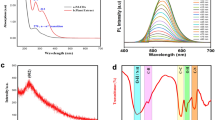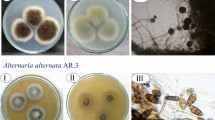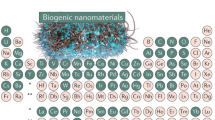Abstract
The synthesis of designer solid-state materials by living organisms is an emerging field in bio-nanotechnology. Key examples include the use of engineered viruses as templates for cobalt oxide (Co3O4) particles1, superparamagnetic cobalt–platinum alloy nanowires2 and gold–cobalt oxide nanowires3 for photovoltaic and battery-related applications. Here, we show that the earthworm's metal detoxification pathway can be exploited to produce luminescent, water-soluble semiconductor cadmium telluride (CdTe) quantum dots that emit in the green region of the visible spectrum when excited in the ultraviolet region. Standard wild-type Lumbricus rubellus earthworms were exposed to soil spiked with CdCl2 and Na2TeO3 salts for 11 days. Luminescent quantum dots were isolated from chloragogenous tissues surrounding the gut of the worm, and were successfully used in live-cell imaging. The addition of polyethylene glycol on the surface of the quantum dots allowed for non-targeted, fluid-phase uptake by macrophage cells.
This is a preview of subscription content, access via your institution
Access options
Subscribe to this journal
Receive 12 print issues and online access
$259.00 per year
only $21.58 per issue
Buy this article
- Purchase on Springer Link
- Instant access to full article PDF
Prices may be subject to local taxes which are calculated during checkout



Similar content being viewed by others
References
Nam, K. T. et al. Stamped microbattery electrodes based on self-assembled M13 viruses. Proc. Natl Acad. Sci. USA 105, 17227–17231 (2008).
Lee, S.-K., Yun, D. S. & Belcher, A. M. Cobalt ion mediated self-assembly of genetically engineered bacteriophage for biomimetic Co–Pt hybrid material. Biomacromolecules 7, 14–17 (2006).
Nam, K. T. et al. Virus-enabled synthesis and assembly of nanowires for lithium ion battery electrodes. Science 312, 885–888 (2006).
Dameron, C. T. et al. Biosynthesis of cadmium-sulphide quantum semiconductor crystallites. Nature 338, 596–597 (1989) .
Sweeney, R. Y. et al. Bacterial biosynthesis of cadmium sulfide nanocrystals. Chem. Biol. 11, 1553–1559 (2004).
Krumov, N., Oder, S., Perner-Nochta, I., Angelov, A. & Posten, C. Accumulation of CdS nanoparticles by yeasts in a fed-batch bioprocess. J. Biotechnol. 132, 481–486 (2007).
Bao, H. et al. Extracellular microbial synthesis of biocompatible CdTe quantum dots. Acta Biomater. 6, 3534–3541 (2010).
Bao, H., Hao, N., Yang, Y. & Zhao, D. Biosynthesis of biocompatible cadmium telluride quantum dots using yeast cells. Nano Res. 3, 481–489 (2010).
Kowshik, M., Vogel, W., Urban, J., Kulkarni, S. K. & Paknikar, K. M. Microbial synthesis of semiconductor PbS nanocrystallites. Adv. Mater. 14, 815–818 (2002).
Kumar, S. A., Ansary, A. A., Ahmad, A. & Khan, M. I. Extracellular biosynthesis of CdSe quantum dots by the fungus, Fusarium oxysporum. J. Biomed. Nanotech. 3, 190–194 (2007).
Khan, M. A. K. & Wang, F. Mercury-selenium compounds and their toxicological significance: toward a molecular understanding of the mercury–selenium antagonism. Environ. Toxicol. Chem. 28, 1567–1577 (2009).
Stürzenbaum, S. R., Winters, C., Galay, M., Morgan, A. J. & Kille, P. Metal ion trafficking in earthworms—identification of a cadmium specific metallothionein. J. Biol. Chem. 276, 34013–34018 (2001).
Stürzenbaum, S. R., Georgiev, O., Morgan, A. J. & Kille, P. Cadmium detoxification in earthworms: from genes to cells. Environ. Sci. Technol. 38, 6283–6289 (2004).
Homa, J., Olchawa, E., Stürzenbaum, S. R., Morgan, A. J. & Plytycz, B. Early-phase immunodetection of metallothionein and heat shock proteins in extruded earthworm coelomocytes after dermal exposure to metal ions. Environ. Pollut. 135, 275–280 (2005).
Morgan, A. J. et al. Differential metallothionein expression in earthworm (Lumbricus rubellus) tissues. Ecotox. Environ. Safety 57, 11–19 (2004).
Jacob, C., Arteel, G. E., Kanda, T., Engman, L. & Sies, H. Water-soluble organotellurium compounds: catalytic protection against peroxynitrite ad and release of zinc from metallothionein. Chem. Res. Toxicol. 13, 3–9 (2000).
Garberg, P. et al. Binding of tellurium to hepatocellular selenoproteins during incubation with inorganic tellurite: consequences for the activity of selenium-dependent glutathione peroxidise. Int. J. Biochem. Cell Biol. 31, 291–301 (1999).
Rogach, A. L. et al. Aqueous synthesis of thiol-capped CdTe nanocrystals: state-of-the-art. J. Phys. Chem. C 111, 14628–14637 (2007).
Cui, R. et al. Controllable synthesis of PbSe nanocubes in aqueous phase using a quasi-biosystem. J. Mater. Chem. 22, 3713–3716 (2012).
Kessi, J. & Hanselmann, K. W. Similarities between the abiotic reduction of selenite with glutathione and the dissimilatory reaction mediated by Rhodospirillum rubrum and Escherichia coli. J. Biol. Chem. 279, 50662–50669 (2004).
Wampler, J. E. & Jamieson, B. G. M. Earthworm bioluminescence: comparative physiology and biochemistry. Comp. Biochem. Physiol. 66B, 43–50 (1980).
Cholewa, J. et al. Autofluorescence in eleocytes of some earthworm species. Folia Histochem. Cytobiol. 44, 65–71 (2006).
Zhu, H. et al. A blue luminescent di-2-pyridylamine cadmium complex with an unexpected arrangement of thiocyanate ligands: a supramolecular layered structure based on hydrogen bonds and π–π stacking interactions. Inorg. Chem. Commun. 4, 577–581 (2001).
McNulty, M., Puljung, M., Jefford, G. & Dubreuil, R. R. Evidence that a copper–metallothionein complex is responsible for fluorescence in acid-secreting cells of the Drosophila stomach. Cell Tissue Res. 304, 383–389 (2001).
Wuister, S. F., Donegá, C. D. M. & Meijerink, A. J. Influence of thiol capping on the exciton luminescence and decay kinetics of CdTe and CdSe quantum dots. J. Phys. Chem. B 108, 17393–17397 (2004).
Kulvietis, V., Streckyte, G. & Rotomskis, R. Spectroscopic investigations of CdTe quantum dot stability in different aqueous media. Lith. J. Phys. 51, 163–171 (2011).
Sheng, Z., Han, H., Hu, X. & Chi, C. One-step growth of high luminescence CdTe quantum dots with low cytotoxicity in ambient atmospheric conditions. Dalton Trans. 39, 7017–7020 (2010).
Ganther, H. E. Reduction of the selenotrisulfide derivative of glutathione to a persulfide analog by glutathione reductase. Biochemistry 10, 4089–4098 (1971).
Acknowledgements
The authors thank P. Kille, C. Winters and A. J. Morgan for their assistance in antibody generation and immunoperoxidase histochemistry, D. Spurgeon for supplying earthworms, W. Maret for useful discussions, the Nikon Imaging Centre at King's College London for assistance with cell imaging and A. Beavil for use of the Horiba FluoroCube. The authors also acknowledge partial funding from the Wellcome Trust EPSRC Centre of Excellence in Medical Engineering (WT 088641/Z/09/Z) and an Erwin Schrödinger Fellowship. TEM images were taken at Leeds Electron Microscopy and Spectroscopy Centre.
Author information
Authors and Affiliations
Contributions
M.G. conceived the concept. M.G. and S.R.S. conceived the experiments. S.R.S., M.G., K.S., L.A.D., M.T. and A.Z. designed the experiments, supervised experiments and wrote the paper. M.H. and S.R.S. carried out experiments with worms and harvested the quantum dots. S.T., A.P., J.L., J.S.B., E.R. and R.A.K. analysed the particles.
Corresponding author
Ethics declarations
Competing interests
The authors declare no competing financial interests.
Supplementary information
Rights and permissions
About this article
Cite this article
Stürzenbaum, S., Höckner, M., Panneerselvam, A. et al. Biosynthesis of luminescent quantum dots in an earthworm. Nature Nanotech 8, 57–60 (2013). https://doi.org/10.1038/nnano.2012.232
Received:
Accepted:
Published:
Issue Date:
DOI: https://doi.org/10.1038/nnano.2012.232
This article is cited by
-
Silver telluride colloidal quantum dot infrared photodetectors and image sensors
Nature Photonics (2024)
-
Low-density polyethylene microplastics partially alleviate the ecotoxicological effects induced by cadmium exposure on the earthworm Eisenia fetida
Soil Ecology Letters (2024)
-
Rapid, Energy-saving Bioinspired Soft Switching Valve Embedded in Snapping Membrane Actuator
Journal of Bionic Engineering (2023)
-
Bioprocess-inspired Actin Biomineralized Hematite Mesocrystals for Energy Storage
Journal of Wuhan University of Technology-Mater. Sci. Ed. (2023)
-
Biosynthesis of quantum dots and their usage in solar cells: insight from the novel researches
International Nano Letters (2022)



